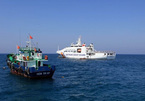Foreign political observers have repeatedly warned that China has installed - possibly permanently - offensive weapons on artificial islands it illegally built in the East Sea.

A Chinese JH-7A fighter aircraft hovers over Phu Lam island (Hoang Sa of Vietnam) in August 2015. - Photo: Ministry of Chinese Defense
The deployment of these weapons is the culmination of a series of tactics, increasingly aggressive actions, and illegal activities in the area for nearly a decade.
In 2015, Chinese President Xi Jinping promised not to militarize the islands in Truong Sa (Spratly) Archipelago that his country built against international laws.
Truong Sa includes the islands comprising coral reefs located east of the East Sea, adjacent to the main sea lines of communication (SLOCs) and where potential marine natural resources are available, such as marine life and oil and gas.
At present, China, along with Brunei, Malaysia, the Philippines and Vietnam, all claim sovereignty over many parts of the islands. However, no country has militarized the islands as quickly and strongly as China. Obviously, China has not been transparent about its intentions to build artificial islands.
China has built runways and ports on some islands that can accommodate military aircraft and warships. By the end of 2016, China had deployed anti-tank guns and close-range interception weapons systems (CIWS) on several of these entities. Notably, there are Gatling guns connected to the sensors, which can operate automatically against aerial threats.
| At present, China, along with Brunei, Malaysia, the Philippines and Vietnam, all claim sovereignty over many parts of the islands. However, no country has militarized the islands as quickly and strongly as China. Obviously, China has not been transparent about its intentions to build artificial islands. |
China was discovered to have deployed anti-ship cruise missiles (ASCMs) and surface-to-air missiles (SAMs) at least on three entities belonging to the Spratly Islands - including Fiery Cross Reef, Mischief Reef and Subi Reef.
SAM system, thought to be HQ-9B, has a range of 200km. China's YJ-12B ASCM is a supersonic missile with a firing range of nearly 300 km. Both of these missiles can be used to intercept ships and threaten other naval forces in a large area in the East Sea.
Along with military actions in Truong Sa, China also has taken similar actions in the Hoang Sa (Paracel) Islands. Beijing has expanded and modernized its entities on Phu Lam Island, extending the island's airport to 2,700m, to accommodate most of the Chinese fighter jets (Chinese J-11B was discovered on this island in 2016). At the same time, Beijing has also improved its port facilities on Phu Lam Island, and early in 2016, it was reported that HQ-9 SAMs were deployed there.
China has also installed many radar stations on most of these islands and gradually carried out air and sea operations in the region. These deployments, plus missile installations, actually put the entire East Sea in the sight of the Chinese army.
Researchers from the US Naval War College warned that Chinese militarizing activities in the region are a plot to create a "strategic strait" in the East Sea. In other words, through the deployment of China's military power (permanent or non-permanent) at both East and West poles of the East Sea, Beijing is seeking to turn this sea area from an international SLOC into a sea route controlled by China, and a "strategic bottleneck" that interferes with other countries.
According to Richard A Bitzinger from the Military Transformations Program at the S Rajaratnam School of International Studies, at Nanyang Technological University in Singapore, China is defying public opinion, attempting to turn the East Sea into Anti Access/Area Denial (A2/AD). This also means driving military rivals, especially the US Navy, out of the region.
In the Asia Times, Bitzinger said that the Chinese plot of turning the East Sea into its territorial waters has had many impacts. It will severely restrict navigation freedom and allow China to "swallow" all marine resources in the region for its own economic interests. In particular, this ploy could make it more difficult for other navies to travel between the Indian Ocean and the Pacific Ocean, and could jeopardize the sovereignty of many countries in the region.
China's intentions in the East Sea have become clearer over the years, and Beijing's decade-long lie has also been exposed.
Ngoc Chau

All nations, big or small, must uphold the rule of law in the East Sea
In a recent interview with VNA, Nguyen Manh Dong, head of the maritime affairs department at the Ministry of Foreign Affairs' National Border Committee, reiterated Vietnam’s consistent policy

US diplomat condemns China over militarisation in East Sea
David Stilwell, Assistant Secretary of State for the Bureau of East Asian and Pacific Affairs, cited Chinese “repeated illegal actions and militarisation” in the East Sea while he testified at the US Senate Foreign Relations Committee.
 China has played a new trick with the "new map of the People's Republic of China", saying that the map was first published in 1951 and has just been "discovered”. The country constantly acts contrary to international laws in the East Sea.
China has played a new trick with the "new map of the People's Republic of China", saying that the map was first published in 1951 and has just been "discovered”. The country constantly acts contrary to international laws in the East Sea.